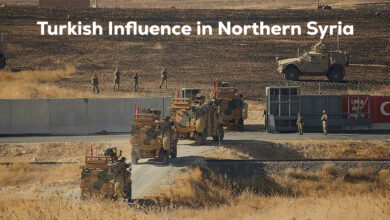The Ottoman National Pact Collides with the Rise of Salafists

Over the past four days, northwest Syria has witnessed dramatic geopolitical shifts. Salafist groups operating under the so-called “Operation Deterrence of Aggression,” led by Hay’at Tahrir al-Sham (formerly Jabhat al-Nusra), have gained full control of rural Idlib and most of Aleppo and its countryside. Simultaneously, Turkish-backed mercenaries participating in the “Operation Dawn of Freedom” have occupied Kurdish areas, displacing more than 120,000 indigenous Kurds in recent days. Many of these displaced individuals had already been uprooted in 2018 when Turkey and its proxies occupied Afrin and its countryside. Reports from residents reached by phone recount killings, torture, and kidnappings of Kurds caught by these forces. Additionally, Turkish-backed factions have imposed a siege on Kurdish neighborhoods in Aleppo, specifically Sheikh Maqsoud and Ashrafieh.
These developments coincide with the collapse of the Syrian regime’s command structure, which some analysts attribute to an attempted military coup in Damascus, timed with the opposition’s offensive. Others link it to an agreement between the regime, Russia, and Turkey, endorsed by Arab and Western powers, as part of efforts to expel Iran from Syria. However, most analyses suggest the start of a new international approach to the Syrian crisis following the stalemate in political negotiations aimed at resolving it.
The Historical Dimension in the Struggle
Many opinions about these changes have overlooked the historical dimension of the conflicts, which, when analyzed through the lens of both subjective and objective factors, often connect to the “butterfly effect” theory (a concept from chaos theory). This framework can be used to pinpoint the origins of crises in the Middle East through two main factors:
- The Ottoman Empire’s failure to undertake a civilizational renaissance after the 18th century.
- The establishment of nation-states after World War II.
These two factors led to the emergence of conflicting ideologies, including political Islam ideologies or those imported from Europe, such as chauvinistic nationalism. Over the past two centuries, such ideologies have fractured Middle Eastern societies and fueled hate speech, with their destructive consequences rippling across the globe.
The political phases of the past 200 years have each featured distinctive intellectual characteristics shaped by the governing systems’ domestic and foreign policies. Historical references frequently highlight the emergence of the Wahhabi movement in the Arabian Peninsula as a pivotal point in the rise of strict sectarian Islamist groups, which many regard as key agents of chaos theory. These groups have significantly influenced the current political events in the region through ideological clashes with nationalists, liberals, communists, and Shiite political movements.
The Ideological Conflict in Historical Context
The ideological struggle in the 18th century Middle East, involving major global powers such as Britain and France, was characterized by:
- The conflict between the Wahhabi-Saudi movement and the Ottoman Empire, which relied on Sufi orders.
- The strategy of Muhammad Ali Pasha, the ambitious Ottoman governor of Egypt influenced by the European Renaissance, in his struggle against both the Ottoman Sultan and the Wahhabi-Saudi movement in 1813.
- The role of Shiite states like the Afsharid (1729–1747) and later the Qajar Empire (1795–1921).
The first Wahhabi uprising was suppressed through collaboration among these three regional actors. The Wahhabis, considered the predecessors of today’s Salafists, challenged the Ottoman caliphate’s legitimacy, declared Shiites as heretics, and rejected cultural openness to the West. Their ideology significantly influenced subsequent Salafist jihadist movements.
The Salafist Evolution and Modern Conflicts
In the early 20th century, the Muslim Brotherhood was established in reaction to the Ottoman Empire’s collapse and the rise of Salafism in Arabia. Despite doctrinal disagreements between them, many Brotherhood leaders joined the Salafist movement, such as Azzam and Zawahiri.
Today’s Salafist ideology, embodied by Hay’at Tahrir al-Sham (HTS), Al-Qaeda, and ISIS, espouses a distinct approach to Islamic governance. Unlike the Turkish or Brotherhood models, these groups emphasize the Qurayshi Arab lineage of the caliph. For example, HTS leader Abu Mohammad al-Julani claims descent from the Prophet’s family and aims to establish a Sunni Arab emirate in Syria, masked by the Salvation Government’s façade of Islamic liberalism.
Meanwhile, ISIS emphasized the “Qurayshi” lineage for its leaders as well, contrasting with the Turkish Islamists’ and Brotherhood’s vision of reviving the Ottoman Misak-ı Milli (National Pact) to create a Sunni (Turkish-Arab) socio-political bloc. This bloc would align economically with Qatar and linguistically unify its citizens under Turkish and Arabic.
Turkey’s Role and Potential Clashes
Despite official denials, Turkey has been involved in the recent battles for Aleppo. Turkish-backed forces launched “Operation Dawn of Freedom” and symbolically raised the Turkish flag over Aleppo Citadel. However, the Justice and Development Party’s (AKP) ideology, allied with the Brotherhood, clashes with HTS’s Salafist project. This ideological discord hints at potential future confrontations, especially as Sunni Arab support for HTS grows.
Videos from recent battles have shown fighters bearing ISIS symbols and chanting its slogans, highlighting the group’s entrenched presence in the region. Meanwhile, Turkish ultra-nationalists have intensified propaganda around Aleppo, with campaigns like “#Aleppo82Province,” spearheaded by Esra Erdoğan, the Turkish president’s daughter.
Future Scenarios and Regional Implications
Turkey’s dominant role in northwest Syria gives it international justification to target HTS, classified as a terrorist organization. However, the Kurdish exodus, the Syrian regime’s retreat, and the absence of a common enemy could spark a conflict between Turkish-backed factions and Salafist groups. Turkey may be forced to align fully with one side, likely the Brotherhood.
Challenges to Turkey’s plans include:
- Salafists’ unwillingness to relinquish Aleppo after recent gains.
- ISIS cells poised to exploit regional instability.
- Russia’s geopolitical interests and national security concerns.
- Iran’s calls for vengeance and its ambition to reclaim Aleppo.
- Arab national security and Israel’s regional expansion.
- The area’s strategic importance to Western interests.
Any major clash between Turkey’s proxies and Salafist factions will likely draw in local, regional, and international powers. The United States and its allies appear determined to prevent a fragile security environment in northwest Syria that threatens European, Israeli, or American interests. This suggests the region is poised for further escalation, potentially pushing Syria toward federalization, confederalism, or even deeper division.




